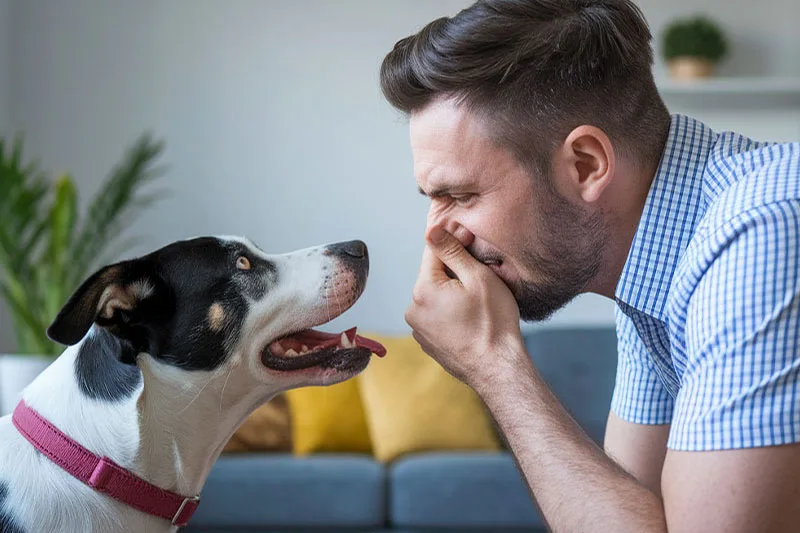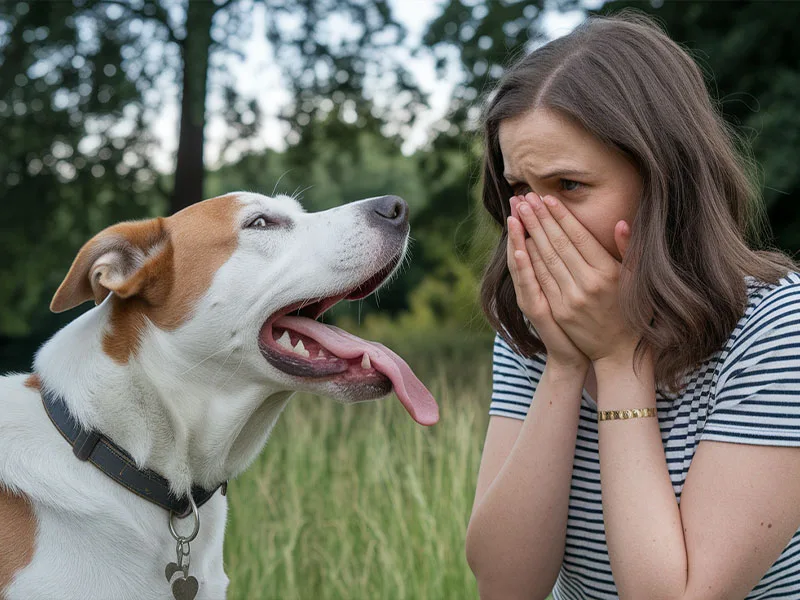My Dog’s Breath Stinks! A Step-by-Step Guide to Fixing Dog Bad Breath

What to Do When Your Dog Has Bad Breath (Halitosis): A Step-by-Step Guide
I knew something was off when my dog, Charlie, jumped up for his usual morning kisses, and I nearly gagged from the smell of his breath. It wasn’t just dog breath—it was something straight out of a garbage can. At first, I laughed it off and thought, “Maybe he just needs a drink of water.” But as the days went by, the stench only got worse. I started avoiding his cuddles (which made me feel terrible), and worst of all, he seemed to be licking his lips a lot and pawing at his mouth.
As a loving pet owner, I knew I had to figure out what was causing his bad breath. After researching, talking to my vet, and trying different remedies, I learned that bad breath (halitosis) in dogs isn’t just gross—it’s often a sign of an underlying health issue. In this guide, I’ll walk you through the possible causes of bad breath, step-by-step solutions, and when to seek veterinary care.
Possible Causes of Bad Breath in Dogs
Bad breath in dogs isn’t just about eating something stinky—it can be a symptom of a bigger health issue. Here are the most common causes:
1. Poor Dental Hygiene (Most Common Cause!) 🦷
Just like humans, dogs need regular dental care. If plaque and tartar build up, bacteria grow and cause bad breath. Over time, this can lead to gingivitis (gum inflammation) and periodontal disease, which are major culprits of smelly dog breath.
2. Diet & Eating Gross Things 🤢
Dogs are opportunistic eaters, which means they often eat things they shouldn’t. If your dog has bad breath, ask yourself:
- Did they eat garbage or rotten food?
- Do they have a habit of eating poop (coprophagia)?
- Are they eating a low-quality diet with lots of fillers and poor ingredients?
Certain diets, especially ones high in fish or protein, can also cause stronger breath odors.
3. Gastrointestinal Problems (Gut Issues) 💨
Sometimes, bad breath isn’t coming from the mouth at all—it’s coming from the stomach. Dogs with acid reflux, indigestion, or other gut issues may have a foul-smelling breath that smells like rotten food or sour milk.
4. Diabetes (Sweet-Smelling Breath) 🍬
If your dog’s breath smells fruity or sweet, it could be a sign of diabetes. Diabetic dogs may also drink excessive water, urinate more often, and lose weight unexpectedly.
5. Kidney Disease (Urine-Like Smell) 🚽
If your dog’s breath smells like ammonia or urine, it could be a sign of kidney disease. The kidneys filter waste, and when they aren’t working properly, toxins build up in the blood, leading to foul breath.
6. Liver Disease (Rotten, Musty Smell) 🦠
Liver problems can also cause horrible-smelling breath along with other symptoms like vomiting, yellowing of the eyes/gums (jaundice), and loss of appetite.
7. Mouth Infections, Tumors, or Foreign Objects 🩸
If your dog suddenly has really bad breath, check their mouth for:
- Infections or abscesses (swollen gums, pus, or bleeding)
- A foreign object stuck (like a piece of a bone or stick)
- Mouth tumors or cysts (which can cause severe odor and discomfort)
Step-by-Step Guide on What to Do
If your dog has bad breath, don’t panic—there are several things you can do at home before rushing to the vet.
1. Inspect Your Dog’s Mouth 👀
✔️ Step 1: Gently lift your dog’s lips and check for red, swollen, or bleeding gums.
✔️ Step 2: Look for yellow or brown tartar buildup on the teeth.
✔️ Step 3: Check for loose, cracked, or broken teeth (which could be infected).
✔️ Step 4: Smell their breath—does it smell rotten, sweet, or like urine?
✔️ Step 5: Check for any foreign objects stuck in their teeth or gums.
🔴 If you notice severe swelling, bleeding, pus, or a growth, it’s time to call the vet!
2. Start Brushing Their Teeth (Daily!) 🪥
One of the easiest ways to eliminate bad breath is by brushing your dog’s teeth daily. Here’s how:
🦴 Step 1: Use a dog-specific toothbrush and toothpaste (never use human toothpaste—it’s toxic to dogs!).
🦴 Step 2: Gently brush in circular motions, focusing on the back molars where plaque builds up.
🦴 Step 3: Reward with treats or playtime so they associate brushing with something positive!
🔹 Pro Tip: If your dog hates toothbrushes, try finger brushes or dental wipes.
3. Provide Dental Chews & Toys 🦷
Certain chew toys and treats help scrape away plaque naturally. Some great options include:
✔️ Dental chews (like Greenies or Whimzees)
✔️ Raw carrots & apples (natural plaque removers!)
✔️ Rubber chew toys (like KONG or Nylabone)
Chewing stimulates saliva production, which helps wash away bacteria and freshen breath.
4. Improve Their Diet 🍖
Switching to a higher-quality diet with fewer fillers and artificial additives can greatly improve breath odor.
🔹 Look for dog food that contains:
✔️ High-quality protein (chicken, beef, turkey, or fish)
✔️ Omega-3 fatty acids (for healthy gums and digestion)
✔️ Limited fillers (corn, wheat, and soy can contribute to bad breath)
5. Add Natural Breath Fresheners 🌿
Want to freshen up your dog’s breath naturally? Try these:
🌿 Fresh parsley – Chop up a small amount and mix it into their food.
🥒 Coconut oil – A teaspoon a day can help fight bacteria and improve breath.
🐾 Probiotics – Helps balance gut bacteria and reduce odor.
🔹 Pro Tip: You can also give your dog an occasional homemade breath treat made with parsley, coconut oil, and mint!
6. Keep Their Water Fresh & Clean 💧
Dogs with dry mouths often have worse breath. Always provide fresh, clean water to keep their mouth hydrated and wash away bacteria.
💡 Pro Tip: Add a dog-safe water additive (like TropiClean) to help reduce plaque and bad breath.
When to Contact a Veterinarian
While mild bad breath is usually just a dental issue, some cases require professional help.
🚨 Call the vet if your dog’s bad breath is accompanied by:
✔️ Severe drooling or difficulty eating
✔️ Swollen, bleeding gums or loose teeth
✔️ Sweet-smelling breath (possible diabetes)
✔️ Urine-smelling breath (possible kidney disease)
✔️ Vomiting, weight loss, or yellow gums (possible liver disease)
A vet may recommend a professional dental cleaning, blood tests, or medications depending on the underlying issue.
Final Thoughts
Bad breath in dogs isn’t just an annoying smell—it’s often a sign of a bigger issue. By brushing their teeth, feeding a healthy diet, and providing the right chews, you can keep their breath fresh and improve their overall health.
But if your dog’s breath still stinks despite your efforts, it’s time to see the vet—because behind every bad smell, there’s a reason that needs to be addressed.
With a little care, your pup will be back to fresh kisses and cuddles in no time! 🐶💕

Worried About Your Pet's Health? Schedule a Checkup!
Don't wait until it's too late. Our compassionate team is dedicated to providing top-notch care. Schedule your pet's checkup today and ensure their well-being.
BOOK A PET CHECKUP
